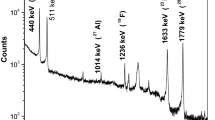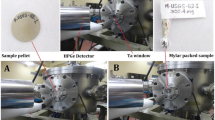Abstract
An external particle induced gamma-ray emission (in air) PIGE facility has been set up for the first time at FOTIA, BARC for rapid and non-destructive quantification of low Z elements. Proton beam of energy of 3.5 MeV was obtained on the target using a 25 μm Tantalum window and Ta collimator of 5 mm diameter. The in situ current normalized PIGE method was validated by quantifying low Z elements in a mixed synthetic standard and in two (certified / standard) reference materials namely USGS CRM G2 and NIST SRM 620. The external PIGE method was applied to lithium-based ceramics, boron carbide and soda-lime and borosilicate glass samples for quantification of low Z elements.





Similar content being viewed by others
References
Acharya RN, Nair AGC, Reddy AVR, Manohar SB (2002) Validation of a neutron activation analysis method using k0-standardization. Appl Radiat Isot 57(3):391–398
Dasari KB, Acharya R, Swain KK, Lakshmana Das N, Reddy AVR (2010) Analysis of large and non-standard geometry samples of ancient potteries by internal monostandard neutron activation analysis using in situ detection efficiency. J Radioanal Nucl Chem 286(2):525–531
Acharya R (2009) Prompt gamma-ray neutron activation analysis methodology for determination of boron from trace to major contents. J Radioanal Nucl Chem 281(2):291–294
Sippel RF, Glover ED (1960) Sedimentary rock analysis by charged particle bombardment. Nuclear Instruments and Methods 9(1):37–48
Grainger MNC, Manley-Harris M, Coulson S (2012) Classification and discrimination of automotive glass using LA-ICP-MS. J Anal At Spectrom 27(9):1413–1422
Šmit Ž, Milavec T, Fajfar H, Rehren T, Lankton JW, Gratuze B (2013) Analysis of glass from the post-Roman settlement Tonovcov grad (Slovenia) by PIXE–PIGE and LA-ICP-MS. Nucl Instrum Methods Phys Res Sect B 311:53–59
Valković O, Jakšić M, Fazinić S, Valković V, Moschini G, Menapace E (1995) Quality control of PIXE and PIGE nuclear analytical techniques in geological and environmental applications. Nucl Instrum Methods Phys Res Sect B 99(1):372–375
Macias ES, Radcliffe CD, Lewis CW, Sawicki CR (1978) Proton induced.gamma.-ray analysis of atmospheric aerosols for carbon, nitrogen, and sulfur composition. Anal Chem 50(8):1120–1124
Volfinger M, Robert JL (1994) Particle-induced-gamma-ray-emission spectrometry applied to the determination of light elements in individual grains of granite minerals. J Radioanal Nucl Chem 185(2):273–291
Savidou A, Aslanoglou X, Paradellis T, Pilakouta M (1999) Proton induced thick target γ-ray yields of light nuclei at the energy region Ep = 1.0–4.1 MeV. Nuclear Instrum Methods Phys Res Sect B Beam Interact Mater Atoms 152(1):12–18
Giuntini L (2011) A review of external microbeams for ion beam analyses. Anal Bioanal Chem 401(3):785–793
Doyle BL, Walsh DS, Lee SR (1991) External micro-ion-beam analysis (X-MIBA). Nucl Instrum Methods Phys Res Sect B 54(1):244–257
Hofsäss H (2018) Evaluation of the radiation hazard for ion-beam analysis with MeV external proton beams (X-IBA). Nucl Instrum Methods Phys Res Sect B 427:53–59
Mathis F, Othmane G, Vrielynck O, Calvo del Castillo H, Chêne G, Dupuis T, Strivay D (2010) Combined PIXE/PIGE and IBIL with external beam applied to the analysis of Merovingian glass beads. Nucl Instrum Methods Phys Res Sect B 268(11):2078–2082
Beck L, Pichon L, Moignard B, Guillou T, Walter P (2011) IBA techniques: examples of useful combinations for the characterisation of cultural heritage materials. Nucl Instrum Methods Phys Res Sect B 269(24):2999–3005
Calligaro T, Coquinot Y, Pichon L, Moignard B (2011) Advances in elemental imaging of rocks using the AGLAE external microbeam. Nucl Instrum Methods Phys Res Sect B 269(20):2364–2372
Calzolai G, Chiari M, Lucarelli F, Nava S, Portarena S (2010) Proton induced γ-ray emission yields for the analysis of light elements in aerosol samples in an external beam set-up. Nucl Instrum Methods Phys Res Sect B 268(10):1540–1545
Lucarelli F, Calzolai G, Chiari M, Giannoni M, Mochi D, Nava S, Carraresi L (2014) The upgraded external-beam PIXE/PIGE set-up at LABEC for very fast measurements on aerosol samples. Nucl Instrum Methods Phys Res Sect B 318:55–59
Lucarelli F, Calzolai G, Chiari M, Nava S, Carraresi L (2018) Study of atmospheric aerosols by IBA techniques: the LABEC experience. Nucl Instrum Methods Phys Res Sect B 417:121–127
Pichon L, Beck L, Walter P, Moignard B, Guillou T (2010) A new mapping acquisition and processing system for simultaneous PIXE-RBS analysis with external beam. Nucl Instrum Methods Phys Res Sect B 268(11):2028–2033
Sokaras D, Bistekos E, Georgiou L, Salomon J, Bogovac M, Aloupi-Siotis E, Paschalis V, Aslani I, Karabagia S, Lagoyannis A, Harissopulos S, Kantarelou V, Karydas A-G (2011) The new external ion beam analysis setup at the Demokritos Tandem accelerator and first applications in cultural heritage. Nucl Instrum Methods Phys Res Sect B 269(5):519–527
Yasuda K, Nomachi M, Sugaya Y, Yamamoto H, Komatsu H (2011) Progress of in-air microbeam system at the Wakasa Wan Energy Research Center. Nucl Instrum Methods Phys Res Sect B 269(20):2180–2183
Chhillar S, Acharya R, Mishra RK, Kaushik CP, Pujari PK (2017) Simultaneous determination of low Z elements in barium borosilicate glass samples by in situ current normalized particle induced gamma-ray emission methods. J Radioanal Nucl Chem 312(3):567–576
Sharma V, Acharya R, Samanta SK, Goswami M, Bagla HK, Pujari PK (2020) Chemical characterization of soda-lime glass samples by in situ current normalised PIGE and conventional INAA methods for forensic applications. J Radioanal Nucl Chem 323:1451–1457
Chhillar S, Acharya R, Sodaye S, Sudarshan K, Santra S, Mishra RK, Kaushik CP, Choudhury RK, Pujari PK (2012) Application of particle induced gamma-ray emission for non-destructive determination of fluorine in barium borosilicate glass samples. J Radioanal Nucl Chem 294(1):115–119
Dhorge PS, Acharya R, Rajurkar NS, Chahar V, Tuli V, Srivastava A, Pujari PK (2017) Quantification of trace fluorine concentrations in soil and food samples from fluoride affected region by in situ current normalized particle induced gamma-ray emission method. J Radioanal Nucl Chem 311(3):1803–1809
Chhillar S, Acharya R, Sodaye S, Pujari PK (2014) Development of particle induced gamma-ray emission methods for nondestructive determination of isotopic composition of boron and its total concentration in natural and enriched samples. Anal Chem 86(22):11167–11173
Li XF, Wang GF, Chu JH, Yu LD (2012) Charge integration in external PIXE–PIGE for the analysis of aerosol samples. Nucl Instrum Methods Phys Res Sect B 289:1–4
Lill JO (1999) Charge integration in external-beam PIXE. Nucl Instrum Methods Phys Res Sect B 150(1):114–117
Acharya R, Pujari PK (2018) Development and applications of in situ current normalized PIGE method using proton beams for quantification of low Z elements. J Radioanal Nucl Chem 318(3):1727–1735
Chhillar S, Acharya R, Pai R, Sodaye s, Mukerjee S, Pujari P (2012) A simple and sensitive particle induced gamma-ray emission method for non-destructive quantification of lithium in lithium doped Nd2Ti2O7 ceramic sample. J Radioanal Nuclear Chem 293:437–441
Chhillar S, Acharya R, Tripathi R, Sodaye S, Sudarshan K, Rout PC, Mukerjee SK, Pujari PK (2015) Compositional characterization of lithium titanate ceramic samples by determining Li, Ti and O concentrations simultaneously using PIGE at 8 MeV proton beam. J Radioanal Nucl Chem 305(2):463–467
Chhillar S, Acharya R, Rao T, Bamankar Y, Mukerjee S, Pujari P, Aggarwal S (2013) Non-destructive compositional analysis of sol–gel synthesized lithium titanate (Li2TiO3) by particle induced gamma-ray emission and instrumental neutron activation analysis. J Radioanal Nucl Chem. https://doi.org/10.1007/s10967-013-2609-5
Raja SW, Acharya R, Pujari PK (2020) Application of PIGE method for quantification of total boron in neutron absorbers and shielding materials and isotopic composition in in-house prepared enriched boron carbide samples. J Radioanal Nucl Chem. https://doi.org/10.1007/s10967-020-07011-0
Acharya R, Raja SW, Chhillar S, Gupta J, Sonber JK, Murthy TSRC, Bhushan KS, Rao Radhika M, Majumdar S, Pujari PK (2018) Non-destructive quantification of total boron and its isotopic composition in boron based refractory materials by PIGE and an inter-comparison study using TIMS and titrimetry. J Anal At Spectrom 33(5):784–791
Shih PY (2003) Properties and FTIR spectra of lead phosphate glasses for nuclear waste immobilization. Mater Chem Phys 80(1):299–304
Acknowledgements
Authors thank Dr. S. Krishnagopal, Head, IADD, Mr. A. Agarwal, OIC, FOTIA, IADD and FOTIA operation crews for their support and co-operation during experiment. Authors thank TIFR target laboratory for providing us thin Tantalum used as window material for extraction of proton beam in air at FOTIA. Authors thank Dr. A.K. Gupta, NPD, BARC and Dr. S. Sodaye, RCD, BARC for their help towards external PIGE set up at FOTIA. Mr. V. Sharma is thankful to Council of Scientific and Industrial Research (CSIR), New Delhi, for Junior Research Fellowship (JRF) and he sincerely thank Director, RC&IG and Head, Radiochemistry Division, BARC and Principal, K.C. College, Mumbai for their support and encouragement.
Author information
Authors and Affiliations
Corresponding author
Additional information
Publisher's Note
Springer Nature remains neutral with regard to jurisdictional claims in published maps and institutional affiliations.
Rights and permissions
About this article
Cite this article
Samanta, S.K., Raja, S.W., Sharma, V. et al. Development of an external (in air) in situ current normalized particle induced gamma-ray emission method utilizing 3.5 MeV proton beam from FOTIA for rapid quantification of low Z elements in glass and ceramic samples. J Radioanal Nucl Chem 325, 923–931 (2020). https://doi.org/10.1007/s10967-020-07266-7
Received:
Published:
Issue Date:
DOI: https://doi.org/10.1007/s10967-020-07266-7




